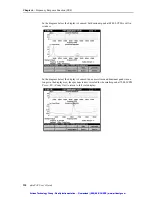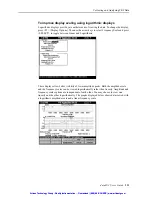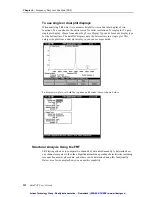
Setting Up FRF Measurements
dataPAC User’s Guide
225
Double Hit (% of Impact)
The double hit detection feature of the FRF Module is a useful tool to help verify the
validity of collected data. It is easy to allow the hammer to bounce once or more when
striking the excitation blow. Even though you may not feel the bouncing, the FRF Module
can detect it by checking the force input signal for any secondary peaks that occur after the
primary excitation peak that exceed this value. This value is expressed as a percentage of the
peak input force—not the overload value that the previous fields use. That means that the
double hit level is much more sensitive to the actual hammer blow force, resulting in a more
accurate detection of hammer bounce. Start with a 5% value for this parameter and adjust if
necessary from the dynamic setup screen.
Arming Mode
This is a convenience feature that controls when new data is sampled. If this field is set to
Auto, anytime the FRF Module detects a hammer blow, it collects new data and overwrites
any data currently being displayed. If this field is set to Manual, you must press <STORE>
before any new input signals are detected and sampled from the hammer. Be careful when
using the Auto mode that the data you are currently viewing isn’t overwritten by an
accidental hammer blow.
Response Channel Setup - Text Mode
Hardware Range
The Hardware Range for FRF measurement can be set to a specific value or automatically
range. The Auto Range setting here is not the same as a typical Auto Range procedure in
any other dataPAC instrument function. The Auto Range setting for FRF requires you to use
the dynamic setup screen to predetermine a range automatically. The dataPAC does not
perform an automatic ranging operation during sampling of the FRF data because no
automatic ranging process is fast enough to prevent loss of FRF data. Therefore, by setting
the range value from a dynamic test performed before collecting data, the dataPAC sets an
acceptable range for the specific test situation without losing data.
The Window, Sensitivity, and Transducer Name fields cannot be changed.
Setting Up the FRF Measurement
In the main setup screen, you set up the FRF measurement parameters.The FRF
measurement parameters are essentially the same as the parameters for a typical spectrum
measurement. The FRF Measurement parameters determine the FFT data format of the
frequency response data. You control the Fmax, lines of resolution, and averaging type to be
used (none or linear). The Fmax and lines of resolution selected here determine the duration
of time waveform collected from both input channels after the hammer blow.
Use the arrow keys to select the field and change it if needed.
The Fmin setting is determined by dividing the Fmax by the lines of resolution. The
Rejection Mode parameter controls how data is averaged. If the Average Type parameter is
set to anything other than None, successive FRF measurements are averaged together.
If the Rejection Mode is set to manual, you must confirm that each collected data set be
allowed to average with previous data and then the result is displayed. If the Rejection Mode
is automatic, the new data averages with the previous sample and displays immediately,
unless an error is detected. Then you are prompted to accept or reject the data.
Artisan Technology Group - Quality Instrumentation ... Guaranteed | (888) 88-SOURCE | www.artisantg.com
Artisan Technology Group - Quality Instrumentation ... Guaranteed | (888) 88-SOURCE | www.artisantg.com






























